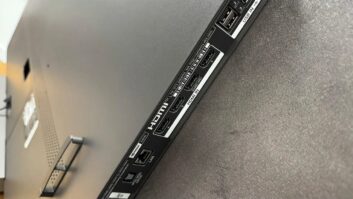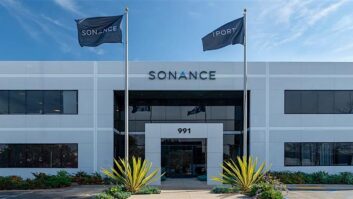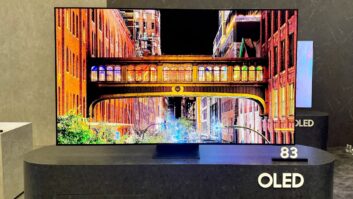EAST RUTHERFORD, N.J. -Sony delivered on its year-old promise to market the industry’s first fully integrated HDTV sets incorporating the i.LINK (IEEE 1394) digital interface connection.
During a 2001 product line review presented to the media here, the company unveiled three HDTV sets that each include integrated ATSC digital tuners and a pair of i.LINK connectors supported with the 5C-endorsed Digital Transmission Content Protection (DTCP) software.
Vic Pacor, Sony Home Networking Products Group president, said his company felt the time was right to release the sets because the FCC recently reiterated its support for the 8-VSB-modulation format in the ATSC Digital TV standard, and because two major Hollywood content producers recently signed off on the use of the i.LINK digital interface supported by the Digital Transmission Content Protection (DTCP) 5C copy-protection system.
Two-weeks earlier, Sony Pictures and Warner Bros. Studios formally announced support for a i.LINK paired with DTCP, the Sony Electronics executive said.
The Sony Pictures and Warner i.LINK/DTCP agreements, “allow the customer to time shift over-the-air commercially interrupted material, provides for record-once subscription-based non-commercially interrupted material [for PVRs and similar devices], and allows them the prerogative to use the copy-never flag for pay-per-view content,” Pacor said.
Sony is aware that some other Hollywood studios appear to be favoring the Digital Video Interface (DVI) standard over the i.LINK format, he said, and Sony Electronics may ultimately decide to embrace that system as well as i.LINK, but i.LINK is apparently the preferred standard by the electronics portion of the company.
“I’d love to see inertia and critical mass build for i.LINK, mainly because we can do more with it [than with DVI],” Pacor said.
The chief drawbacks to DVI are that it is not a bidirectional connector, and it is designed to transport uncompressed digital signals, requiring costly encoders in products to ship content between different components in future A/V home networks.
The new HDTV sets are all configured to the widescreen 16:9 aspect ratio, and are part of Sony’s high-end XBR series. Models include a 34-inch widescreen FD Trinitron Wega set (KD-34XBR2), a 57-inch rear-projection set (KDP-57XBR2) and a 65-inch wide-screen rear-projection set (KDP-65XBR2). They are expected to ship this fall at estimated street retail prices of $4,000, $5,000 and $6,000, respectively.
Each set features Digital Reality Creation (DRC) Multi-Function and Cine-Motion 3:2 pull-down technology. The DRC circuitry upconverts NTSC material to either 960i or 480p scan formats, while CineMotion converts 24-frame per second film-based material into video format without artifacts.
The Multi-Image Driver-X (MID-X) chipsets enable viewers to simultaneously watch NTSC and high-definition programming side by side, using the sets’ Flexible Twin View two-tuner picture-in-picture function. Other features include two HD component video inputs for broadband analog signal sources.
The projection models also add a new high-definition Microfocus cathode-ray tube technology that Sony said improves clarity and sharpness over prior systems, and the Flash Focus fully automatic digital convergence system.
Also unveiled was an assortment of next-generation Hi-Scan HDTV monitors, highlighted by the KV-40XBR700 40-inch 4:3 FD Trinitron Wega direct-view model that made its debut at the Consumer Electronics Show in January. The $3,499 HDTV set (also due in the fall) will present 1080i images in letterbox form with full up-and-down 1080i raster scanning.
Other HD Wega models include two XBR units in the 32-inch (KV-32XBR450) and 36-inch (KV-36XBR450) 4:3 screen sizes. Both use DRC Multifunction and MID-X with CineMotion reverse 3:2 pull-down picture processing and will ship in July at street prices around $2,000 and $2,500, respectively.
Sony also plans to offer a 32-inch (KV-32HS20) model and a 36-inch (KV-36HS20) model in the HS series. Both have the 1080i Hi-Scan chassis for HDTV display (full raster scanning top to bottom), and the DRC Multifunction feature. They will ship in July at anticipated street prices of $1,900 and $2,400, respectively.
Rear-projection Hi-Scan HDTV monitors in the 16:9 widescreen format include the 51W-inch (KP-51HW40, $3,500 street) and 57W-inch (KP-57HW40, $4,000). Both will ship in October. In the 4:3 HS series are the 53-inch (KP-53HS30, $2,800 street) and 61-inch (KP-61HS30, $3,300) screen sizes, both will ship in August.
Highlighting the 4:3 Hi-Scan offerings is the company’s first 43-inch tabletop Hi-Scan projection set, which will carry an estimated street price of $2,500 when it arrives in August.
All Hi-Scan rear-projection models include FlashFocus, MID-X and DRC Multifunction.
Pacor said Sony’s FD Trinitron Wega line would include a total of 26 models in 2001. He reported the Sony flat-screen direct-view CRT series sold more than 1.5 million units in fiscal-year 2000.
New to the Wega line will be entry-level FS series models and the step-up FV line in 20-, 27-, 32- and 36-inch screen sizes. New models include improved two-way speakers, amp and control panel. Larger-screen models also include a two-tuner picture in picture function.
New Wega models are slated to begin shipping in July with estimated street prices ranging from about $350 to $1,800.
New analog projection TVs are positioned in the entry-level S and step-up V series, and include the 48-, 53- and 61-inch screen sizes. Prices will range from $1,700 to $2,200, when they start shipping in July.













